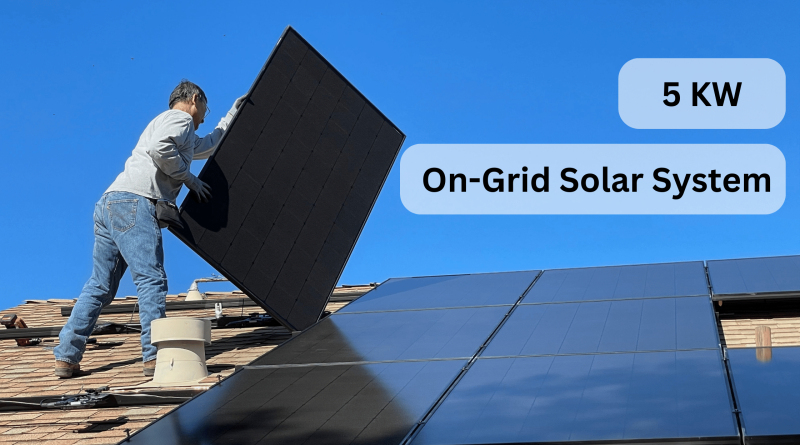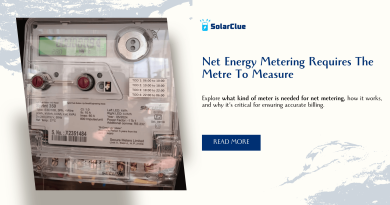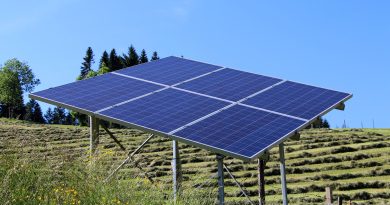Exploring the Benefits of a 5 KW On-Grid Solar System
The term “5 kilowatts” describes the system’s ability to generate up to 5 kilowatts of power at a time in a suitable climate. A 5-kilowatt on-grid solar panel system consists of solar panels designed to generate electricity from sunlight and feed it directly into the local utility grid. These systems include photovoltaic (PV) panels, inverters, mounting hardware, and other essential components.
Table of Contents
Benefits of a 5 kW On-Grid Solar System:
- Your electricity bills will be reduced significantly.
- By using solar power, you contribute to lessening the impact of climate change.
- Moving on to the third aspect, “Return on Investment,” Although upfront costs may seem substantial, the savings over time can generate a positive return on investment, making it a wise economic decision.
- When connected to the grid, you can use it as a backup source of energy if your solar panels aren’t producing enough, ensuring a steady supply of electricity.
- Furthermore, many areas offer net metering programmes that allow you to get paid or reimbursed for any extra energy your device produces and feeds back into the grid.
- Moreover, since solar panels typically require little maintenance and have a long lifespan, they offer a hassle-free option.
Components of a 5kw On-Grid Solar System:
Solar energy systems: These solar-powered panels collect light and transform it into electricity, frequently using photovoltaic silicon cells.
Inverter: The solar panels’ DC (direct current) electricity is transformed into AC (alternating current), which may be used in homes and businesses, by the inverter.
Mounting System: To maximise sunshine exposure, racks and mounting systems firmly place solar panels on roofs or other structures.
Wiring and Connectors: A full electrical circuit is created by the connections made by the wiring and connectors between the solar panels, inverter, and other parts.
Monitoring System: A number of systems come with monitoring technology that allows users to keep tabs on the solar panels’ operation and energy output in real time.
Installation Process:
- Site Evaluation: A solar expert assesses the suitability of your property for solar installation, taking into account elements such as sunshine exposure, shade, and structural integrity.
- Design and Permitting: The assessment is used to generate a unique system design. This plan has been submitted for regulatory and permitting approval.
- Installation: The design is followed when installing the solar panels and other components, and electrical connections are created.
- Inverter Setup: The inverter is set up to maximise energy conversion and grid synchronisation.
- Inspection and Connection: Local officials examine the system to confirm that rules are being followed. The system is linked to the grid once it has been approved.
Impact on Energy Bills:
You may significantly reduce your electricity costs by installing a 5 kW on-grid solar system. When the sun is shining brightly, your device will produce extra energy that can be released into the grid to generate credits or payments. You can continue to draw power from the grid as normal during the day and at night when your energy needs exceed your solar output. You can get a 5 kW on-grid solar system in Solarclue.
Final thoughts
A five kW on-grid solar panel gadget provides a convincing solution for individuals and organisations looking to adopt simple power and lessen their environmental impact. This solar alternative is a desirable investment due to its combination of financial savings, grid connectivity, and significant environmental impact. A five kW on-grid sun device can open the door to a more promising and sustainable future as the industry continues to move towards sustainable energy sources.
On average, a 5 KW solar system requires approximately 300-500 square feet of space, depending on factors like panel efficiency and sunlight exposure.
Yes, a 5 KW solar system is designed to meet the energy needs of a typical household, covering a significant portion of daily electricity consumption.
Typically, on-grid solar systems last 25 to 30 years with proper maintenance, providing a long-term and reliable source of clean energy.
No, on-grid systems shut down during power outages for safety reasons. To have power during outages, consider a hybrid or off-grid solar system.
Yes, many governments offer incentives, tax credits, and rebates to promote solar adoption, making it a financially advantageous decision for homeowners.
By generating clean energy, a 5 KW solar system significantly reduces reliance on fossil fuels, helping decrease carbon emissions and combat climate change.
Regular maintenance includes cleaning panels, checking inverters, and inspecting wiring. Professional inspections ensure optimal system performance.
In many cases, yes. Consult with a solar professional to assess your system’s capacity and determine the feasibility of expansion.
Costs vary based on factors like location, panel type, and installation. On average, prices range from ₹3,50,000 to ₹5,25,000 before incentives.
Yes, various financing options, including loans and leasing, make solar systems more accessible. Explore these to find the best fit for your budget.




